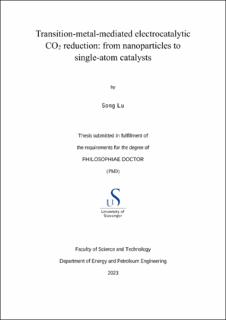| dc.description.abstract | With the rapid development of the global economy, energy crisis and environment issues have become increasingly prominent. Carbon dioxide (CO2) is a primary greenhouse gas (CHG), while it could also be a valuable carbon source. In recent years, electrochemical CO2 reduction reaction (ECR) has received considerable attention among various CO2 conversion technologies. Nevertheless, physicochemical properties of the CO2 molecule make electrochemical conversion of CO2 challenging. Despite that great progress has been made to exploit electrocatalysts for ECR, the process is still impeded by the sluggish kinetics, poor product selectivity, catalyst deactivation, and high overpotential. Therefore, it is highly desirable to develop electrocatalysts with high activity and selectivity for ECR.
Loading metal nanoparticles (NPs) on two-dimensional (2D) materials as electrocatalysts for ECR has been reported extensively in literature. Herein, we studied silver loaded boron-doped g-C3N4 nanocomposite (Ag-B-g-C3N4) for efficient ECR to CO by combined experimental work and first-principles study. Theoretical simulation demonstrated that introduction of Ag NPs and the B atom could greatly decrease the adsorption free energy for the *COOH intermediate generation. B-g-C3N4 could not exhibit the obvious enhancement of ECR performance, while the Ag-B-g-C3N4 catalyst exhibited a total current density of 2.08 mA cm–2 and a CO Faradaic efficiency of 93.2% under the potential of −0.8 V vs the reversible hydrogen electrode (RHE).
It has been well established that the catalytic activity can be further improved by reducing the size of catalysts. Specifically, single atoms catalysts (SACs) with single atom as active center have aroused huge interest due to maximum atom utilization and excellent performance in various catalytic reactions. Therefore, we investigated the single transition metal atoms (V, Cr, Mn, Fe, Co, Ni) embedded O group terminated Nb2N monolayer (Nb2NO2) as ECR catalysts by first-principles calculation. It is found that TM@Nb2NO2 show excellent CO2 adsorption capacity, which benefits CO2 activation. V, Cr and Ni@ Nb2NO2 are identified as efficient electrocatalysts for ECR to CH4.
Subsequently, 2D metal material antimonene from VA group have been studied as support for single transition metal atoms (TM = Sc, Ti, V, Cr, Mn, Fe, Co, Ni, Cu, Zn, Mo, Ru, Rh, Pd, Ag, Cd, Ir, Pt and Au) atoms in ECR by first-principles calculation. Interestingly, non-precious TM atoms supported on Sb monolayer show higher ECR selectivity than hydrogen evolution reaction (HER). Moreover, the primary ECR product of these non-precious metal-based SACs is CH4, except for Zn which produces HCOOH. The interaction between TM atom and Sb monolayer greatly affects the intrinsic activity of SACs.
The intrinsic activity of SACs for ECR could be further enhanced by coordination environment. Therefore, we prepared N, S-codoped carbon black incorporating Ni single atoms as SAC for ECR. The Ni-NS-C catalyst exhibited a very high conversion efficiency of 99.7 % to CO with a high total current density of 20.5 mA cm−2 under −0.8 V (vs. RHE), outperforming S-free Ni−N−C electrocatalyst. It also displayed excellent stability without activity decay after electrocatalysis for 19 h. A combination of experimental investigations and first-principles calculation demonstrates that the high activity and selectivity of ECR to CO is due to a synergistic effect of the S and Ni−NX moieties.
Furthermore, it is worth noting that most studies could only reveal inadequate structural details of metal centers and NM ligands in M−N−C due to the limitations of experimental techniques. Meanwhile, structures with subtle differences are treated similarly, resulting in ambiguous reaction mechanisms on active centers. Therefore, a series of NM heteroatom dopants modified TM@N4 configurations embedded on graphene sheet are proposed. We performed a computational screening of the ECR to CO activity and stability of the NM decorated TM@N4. We found that NM atoms could effectively improve the ECR activity to CO on Ni and Cu@N4 but deteriorate the ECR activity on Co@N4. However, NM dopants could not break linear relationship between key intermediates for the catalysts.
Except for NM atom modifying SACs properties, constructing heteronuclear dimer sites to form dual-atom catalysts (DACs) is another efficient way to tune the coordination environment and the electronic properties of the SAC active centers. Therefore, Mn and Ni SACs, Mn and Ni homonuclear DACs, and Mn−Ni heteronuclear DAC were synthesized. Mn−Ni DAC displayed the highest CO Faradaic efficiency of 98.7% at −0.7 V versus reversible hydrogen electrode (vs. RHE) with CO partial current density of 16.8 mA cm-2 and excellent stability. First-principles calculation disclosed that high valence state of Mn atom and low valence state of Ni atom could deteriorate *CO desorption and enhance *COOH binding strength. Moreover, the active sites of Mn−Ni−NC could facilitate CO2 protonation by enhanced *COOH adsorption because C and O atom of *COOH prefer to bind Ni and Mn atoms, respectively. During the *CO desorption process, only Ni atom bonds with C atom of *CO, promoting *CO desorption. Therefore, the scaling relationship between binding strength of intermediates was broken, resulting in superior performance for the Mn−Ni−NC catalyst in ECR to CO. | en_US |

